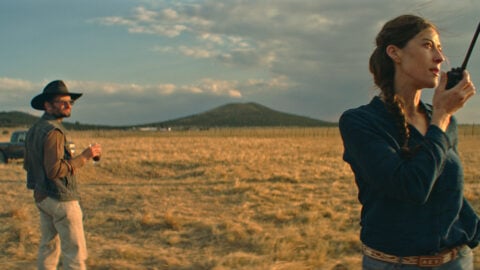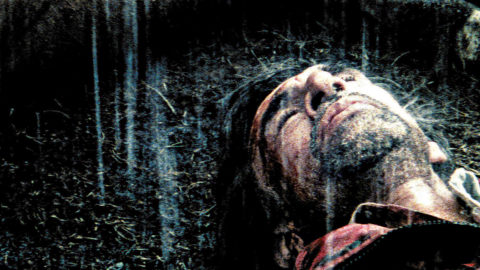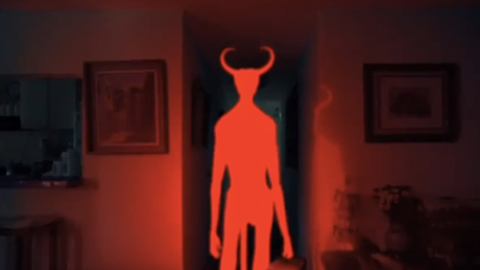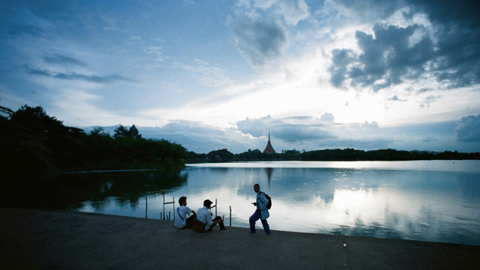Interview: Carlos Reygadas
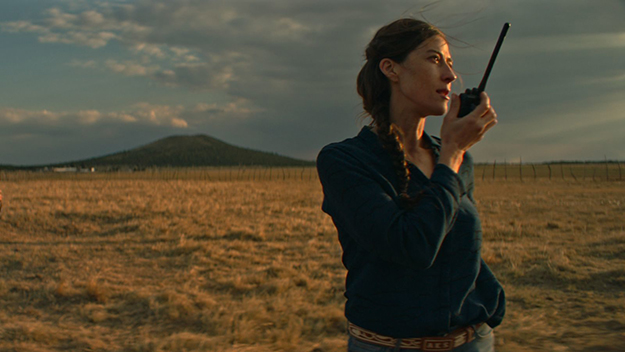
Images from Our Time (Carlos Reygadas, 2018)
Carlos Reygadas’s fifth feature captures the turmoil and ardor of marital upheaval, and the tranquility and violence that occur in places where the domestic and natural worlds meet. Set primarily in and around Reygadas’s Mexican ranch home, Our Time is a uniquely cinematic fabrication with an unusually confluent relationship to its author’s reality. It features Reygadas and Natalia López, his spouse and frequent collaborator, in the roles of Juan and Esther, a husband and wife struggling to navigate the boundaries of an open relationship. (The couple’s children appear in the roles of Juan and Esther’s children.) As Eric Hynes wrote about the film in the March-April 2019 issue of Film Comment: “The mud is mud. The land is land. The animals are animals. And performance side, the bodies are real. This is always the case with live-action films, but we’re rarely invited to think about it, to confront the fact that much of what’s contained in the diorama also transcends it.”
The following conversation transpired piecemeal over the course of several days in February, while Reygadas was tending to the demands of family, work, and upkeep—activities refracted into the fiction of Our Time. By turns generous and contrarian, insightful and ornery, mischievous and amiable, Reygadas has a way of evading a question while offering responses that sometimes turn out richer or more generative than those originally sought. Much of what emerged from our exchange were ideas about art and life that hover in some liminal space that is entirely true to the nature of Reygadas’s films, which brim with startling juxtapositions and possess a remarkable ability to engender radically different reactions with each viewing, prompting us to grapple with provocations whose precise spiritual or political meanings are designed to remain out of reach. Our Time opens on June 14, preceded by a retrospective of the director’s work at the Museum of the Moving Image beginning June 8.
What are the origins of Our Time? What questions propelled it into being?
My films deal with human contradiction. In long-term relationships, with their mix of expectations, with the instinct to care for the other and desire to keep on living a fulfilling life, such contradictions will always come forward. I thought this would be interesting to explore. What I wanted was to put a couple in this complicated situation and see how two individuals—or, even more extreme, one individual—would deal with it. That’s probably what I’ve done in all my films.
This is a short and simple answer, but the origin of a film, the questions of a film, which seem so important for other filmmakers are, for me, almost irrelevant. I don’t know where these things really come from and I don’t really care. I don’t need to know. I try not to intellectualize a film’s driving force. I don’t want to ask myself why. What matters is the how. To see life unfolding. People unfolding. Events unfolding.
This makes me reflect on your choice of title, which lends itself to many readings. It implies something both shared and finite, something precious, something belonging not only to Juan and Ester, but also to everyone experiencing the film.
You’re right. The title refers to the unfolding of events in time, which is, as Tarkovsky suggested, the third dimension of cinema. The concept of presence in cinema is, for me, its capital aspect. And this presence is not only a physical presence, captured from a specific angle but, rather, something that exists in time. Therefore the presence is not only physical; we’re dealing with the presence of feelings as well. You can create a present emotional dimension. That’s what I care most about in cinema.
To what degree was Our Time an opportunity to expand upon elements found in Silent Light [2007]? Beyond the obvious return to the dynamics of the love triangle, there’s also the repurposing of the name Ester, the meditation on familial bonds and domestic idyll, and sequences of pastoral languor. I’m not suggesting that you sought to repeat anything, but that, perhaps, the experience of the earlier film left a residue on you, feelings to be reckoned with in a new context.
I would think that because films are connected to the human being that makes them—we’re talking not about films for entertainment but, rather, films that arise out of an internal necessity—then the filmmaker’s internal world is going to come out all the time no matter what he does. I’m a married man and I have children. I have a fairly ordinary life in that sense. So this shows up in my films. If I were a drug dealer or gangster, the human contradictions I speak of would arise in questions regarding who one has to kill, but this is my life and these things turn up in my films.
The fact that the woman is called Ester and the man Juan, which is also a name I’ve used before: I just felt that giving characters special names every time is somehow artificial. I know this seems absurd, because I’m already creating characters that are artificial. Everything is artificial in film. I just had this intuition that all the female characters in my films should be Ester and the men Juan. It’s not programmatic. I just have this feeling that giving them names is very literary, very much in the realm of representation rather than presentation. You might ask why I don’t give the characters the actors’ names. I did this with Natalia in Post Tenebras Lux [2012]. But that doesn’t really make sense either because what you’re seeing is not these people with their names: it’s their presence and energy and their names are not part of who they are, really, though I know some people re-baptize themselves and take on new names. Personally, I think a name is something completely accessorial. But keeping these simple names from film to film can be misleading and problematic, so I don’t know what I’ll do in the future.
You’ve mentioned elsewhere that you cast Natalia, your kids, and yourself in Our Time for practical reasons, but one could just as easily imagine this tactic being extremely impractical, that your proximity to each other, your intimacies and histories, could creep into the process and create friction and confusion.
There’s an active cause for such things and a hidden cause that only emerges later. The active cause was that I realized the children had to be mine because I’m the parent responsible for them. It wouldn’t make sense to hire someone else’s children when mine could be in the film. They were happy with it, so it was a straightforward choice. My wife was a discovery while I was doing the casting. I realized she’d be perfect. As for myself, I started with someone else, but it just didn’t work.
In my opinion, all this should be a banality. It’s like I’m doing a little Christmas pageant at home: I use what I have at hand. I know this is completely opposed to the idea of industrial cinema, but why should it matter who takes on roles? The important thing is that this is fiction. The presence of humans, objects, landscapes: these are the things you make a film out of. It’s about sharing feelings, prompting feelings in others, reaching some elevation. All these other things don’t matter. I’m sorry to disappoint you and maybe some readers, but what you bring into a film—which isn’t theater or method acting or representing a character—isn’t your own intimacy. Intimacy is never in your bedroom or your underwear or even your naked body. This idea is so bourgeois. It’s only external. Real intimacy is in your heart, in your mind, or in your soul, if you want to think that way. That’s something that doesn’t go into the film. What goes into the film is your presence. Of course, part of that presence involves psychology and character, but it’s not as if you have direct access to the person—you have access to his or her presence.
I’m aware of the fact that many viewers, especially critics or those that have a critical view of the film and want to intellectualize it, will probably think Our Time is a reenactment of life or a happening or something meta-cinematographical. And it may be so, you know? It doesn’t matter. The important thing is the outcome. Some really dumb viewers think I cast the film this way out of vanity, to show that I’m a good horseback rider or that my children are nice kids or something like that. Some have labeled Our Time as self-indulgent. It’s completely the opposite: I’m trying to serve the film with whatever is at hand. I don’t see anything vain in having myself in the film. I actually didn’t want to do it, but in the end it was very sensible.
Fiction can transcend itself when you realize that behind it is the actuality of things. Like in Japón [2002], when you have these workers that say the people from the film didn’t give us anything to eat or drink. Or when a child looks into the camera. It would be completely different if it were a Hitchcock film or a Sylvester Stallone film. Everything would collapse. When fiction is being constructed with the real, it doesn’t collapse. It becomes stronger.
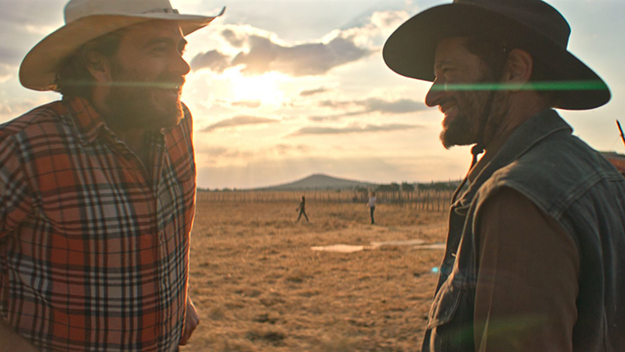
That scene in which Juan’s son mentions Joseph Conrad needing to feel out of his comfort zone to find inspiration: do you relate to this idea?
That’s a cliché. I don’t work that way. I don’t have to feel uncomfortable to work. My curiosity is never satisfied—it’s always ringing. I confess that I don’t even know if Joseph Conrad said that. Probably not. I made it up, I have to tell you. That’s the kind of thing that’s permitted in cinema. It’s the kind of thing that a literature professor would make up in school. But whether this was the case for Joseph Conrad or not, it would be completely irrelevant.
I have to tell you that casting myself was very important. It didn’t make me at all uncomfortable. What you see there doesn’t continue into real life. Immediately after a take we were talking about something else. The feelings depicted exist in us, but we didn’t direct them at each other. As anyone on the crew could confirm, it was a wonderful time, a holiday, in a way, from our everyday lives. The children were off on their own; they had friends over. Sometimes they didn’t like acting because they wanted to keep playing fútbol. Natalia would go off and read and then I would call her and she would come to do what needed to be done. The presence in the film is Natalia’s, not the psychology.
Sexual encounters, whether transgressive, ethereal, or at the very least unusual, form a steady motif in your films. What is it about sex that keeps calling you back?
Sex is very present in the lives of humans, of most animals. I make films about humans living more or less ordinary lives. They’re never space agents or spies or saving the planet. They’re just ordinary people going through difficult or especially dense moments in life. Most ordinary people have sex or wish they could. Some have abolished it from their lives, but that’s rare. It just happens that in cinema sex is not very present because there’s no need for it. Since most of cinema is illustrated literature, then it’s a waste of time showing sex when you could just suggest it. In my cinema, the actual unfolding of events is what matters, so things must be shown, rather than alluded to. This goes for the way people eat, talk, sit in cars, have sex, and go around living their life.
This is your first collaboration with cinematographer Diego García, whose work with Apichatpong Weerasethakul and Gabriel Mascaro has been revelatory with regard to the camera’s relationship to bodies in space. What can you say about what you sought from him as a collaborator? What were your working methods like? Were they changed by having you in front of the camera?
It’s been a pleasure to work with Diego. He’s an artist and I’ve always looked for artists when I make films. But I am a visual filmmaker. I visualize shots from the earliest stages. I walk around in the places where we shoot. Contrary to what many people think, this is where photography starts, when you walk around and start visualizing a film, often on your own, as a director. As I see it, many film directors are really theater directors or writers illustrating literature with film, so it’s very common to let the director of photography take control of your visual language. But there are other filmmakers that construct their visual language themselves from the beginning. In these cases the role of the director of photography is different. He’s not building the images; he becomes a mirror, an artist with whom the filmmaker realizes his ideas and ensures that they can work. I’m not diminishing the role of the director of photography but, rather, increasing it. He’s a very important collaborator. But while I’ve worked with three different cinematographers, the visual language is my own. It will always be my own. There’s no pretension in this, I’m just telling you that the images came to me while scouting, drawing, and writing. The design of the images is what matters, so my being in front of the camera didn’t really make a difference. Visual filmmakers always have a style that changes very little. Think of Kubrick or Tarkovsky—it’s not a matter of being in the same league as them—these guys changed their directors of photography all the time, but nothing in their visual language ever changed.
By the way, no one asks me the same questions about the art director or the sound guys, how they help me build the sounds in the film. The poor sound guys, which in my opinion are as important as the cinematographers, are rarely considered.
I couldn’t agree more. So let’s talk about this. How does the development of sound in your films work? I assume [mixer and recordist] Raúl Locatelli and [designer and editor] Javier Umpierrez play pivotal roles in the team?
I would say that you’re thinking very traditionally again. You’re thinking within the framework of cinema as it’s used to illustrate literature. In this system the director is hired, the director of photography and his crew are hired to develop the visual language, the sound people are hired to develop the sound. But I think cinema is something else. In this other cinema the filmmaker works differently. The conception of sound and image comes from him. Cinema is a collective undertaking, but artistic responsibility belongs to only one person. It’s not Javier or Raúl who offers the sound’s vision. Raúl is an amazing sound engineer who always lets me know what works, what doesn’t, which are the best microphones. He’s a great technician and he has taste—though that doesn’t really matter in the end because it’s the director’s taste that will decide. The same thing goes for the sound designer and his cohort, and here I would include Jaime Baksht and Carlos Cortés, who are the mixers.
If what you care about is illustrating literature, then sound becomes what it usually is, which is first of all making sure the story is told and things are very clear, and then adding some fancy, often loud elements, atmospheres, crashes, everything that calls the attention of the audience member unidirectionally. Foleys, explosions, anything like that. When you’re no longer concerned about telling stories but rather about the presence of objects, places, and living entities, then sound is absolutely natural. There’s nothing special about it. Presence is right there in front of you. You see it and you hear it. Whatever is present creates noise. With my previous films I’ve often been asked about silence. Apparently people consider silence to be the absence of words or loud sounds. Actually, in my films there is never silence. There’s always noise. So rather than thinking about it in such a programmatic way, as your question implies, I would rather connect as much as I can to presence. As I spend time conceiving the characters and the places they inhabit, I’m also hearing things.
Does your feeling about sound change as you move from rural to urban spaces? It’s a dichotomy from which a lot of tension arises in your work. During that sequence in Mexico City, with the street images around Bellas Artes, the soundtrack is taken exclusively from the concert Ester is attending, rather than from the street itself.
All that is the presence of the city itself. That’s how it looks, that’s how it sounds. That’s exactly what you get if you sit in that place and you point a camera in the correct direction and you have the right sound equipment to record it. At the time of shooting you have to find this peace, this passiveness, this sense of pause, where you let these amazing devices work and receive. There are three stages in cinema. The planning stage has to be very deep and precise. During the second stage you have to be passive, to let presence come into the funnel of the camera and the sound devices. Then there’s the third stage, which is postproduction, editing, sound mixing, color, and so on. I want to emphasize this second stage, where you have to be very passive, with open eyes, open soul, open mind, open ears. At this stage, the better that you’ve planned things, the better you’ll be at improvising.
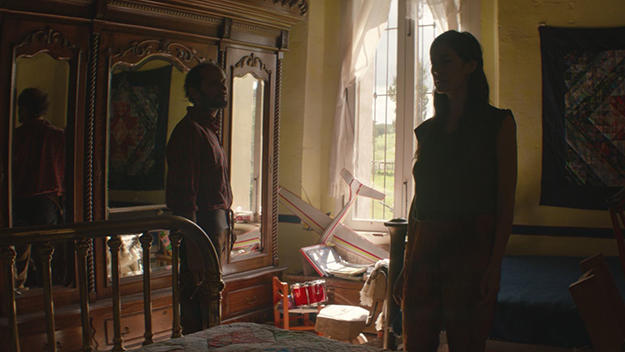
Since we’re talking about receiving and improvising, I wonder if you could give an example of something in the finished film that wasn’t planned, something only discovered during the filming.
This is a pertinent question, because I talk so much about planning. I do storyboards and very precise paper cuts. I’m the kind of filmmaker that does his editing in-camera almost. I use the editing room as a fine-tuning place, a garbage place—and also a hospital. [Laughs] The editing room isn’t where I “find” the film. But this can make it seem like we’re very rigid when shooting, and this is not at all the case. Rather than give you an example of one shot that was discovered during editing, I’ll tell you that in everything you see in the film, there exists something that was discovered during the filming. It could be the light. It could be a pothole that a horse ran through, and water that we weren’t expecting, and we adapt to that. If you see a film like Vertigo, for example, everything is usually executed in a studio under maximum control. By contrast, you’ll see in Our Time that my hair, for example, is improvised. The makeup is put together on the spot. A lot of the clothing is changed on the spot. Birds, wind, all the accents of nature are found on the spot. The film is still being born during the shooting. My films are born the way kangaroos are born. Or dogs. I always think the film is born when I write it, because that’s the moment when I describe shots. I hear, I see, I feel all these things and I describe them. But actually it’s not complete. I don’t know what you know about dogs, but after they’re born they spend a lot of days with their eyes closed and their hearing not yet developed. Part of their breeding is still happening while they’re being nursed as a pack.
I’ll give precise examples. You’ll remember the moment in Japón when this man sings. While they’re destroying the house, I asked him to sing this little song, but he changed it. He wanted to be more present and gave us this huge song and I just let it roll. In Our Time, all the scenes where we’re having breakfast with the children were found. Everything is planned and then found. It’s like animal documentaries. They put food here and there, hide cameras here and there, but then, of course, you can’t direct the animals so what happens, happens. It’s not exactly improvisation. When we shot those breakfasts, the camera is just there and we’re having real breakfast, real conversation. I had already written what I wanted, so I tried to induce these subjects. They happened in a different manner than I expected, but you’d think it was all staged because the result resembles the storyboard so closely. The energy can be different. The content can change slightly. The inflection of a voice or a word chosen. It’s different from complete improvisation and it’s different from a Hitchcock film. It’s very much like a blueprint for an architect. You have this precise document to follow, but then you realize that some element is to big or too small, that there’s too much wind or too much light or something you didn’t expect, so you use what’s there and allow this to change the shape of the thing. The scenes with children are good examples, as well as those involving animals.
Speaking of animals, I wanted to ask you about Our Time’s closing sequence, which is probably my favorite in the film, with the bulls in the mist and King Crimson’s “Islands” infusing the aural space. I find it very moving for reasons that clearly resonate with the human drama and others that are harder to articulate. I wonder if you could say something about how this sequence became the film’s coda.
In bullfighting breeding ranches, one of the worst losses occurs when there’s fighting between the bulls. They fight because that’s how these mammals are. It’s not what they symbolize or what they represent—it’s how they are. They’re fighting right now, in ranches in Spain or Mexico or Colombia, just as deer are fighting in the mountains all the time. That’s the main reason they have horns, to hurt each other and defend each other. I’m not trying to make a big point about violence or masochism, which I find so stupid. I’m not introducing it as a metaphor. I’m just acknowledging that this is something that happens between mammals on this planet. This is what happens on a ranch. This can also be something of a reflection on the rest of the film, though not directly—the two men are never violent with each other at all. I’m reflecting on things that unfold in a place like this, on nature and life as we know it. So I thought that would be a proper ending for the film, just as the ending of Silent Light is the sunset and the stars. Our Time opens with children and finishes with animals. We creatures fight, we play, we have sex, we eat. And we humans think and acknowledge that we’re alive.
I’ve always thought of films as bilateral entities, which is to say ambiguous things, things that are only complete once they’ve reached the minds that connect with them. A classic narrative film is unilateral in that it disembarks from the screen onto the viewer and is meant not to be ambiguous, to lead you, to inform you, to make you laugh or cry or whatever, in a specific manner. The moments in Hitchcock that make you afraid are meant to make everybody afraid. It’s disembarking on you, like a circus. It’s entertainment, perhaps of very good quality, but still entertainment because it’s only coming in one way. In the films I’m trying to make, which are about presence, rather than representation, things don’t inform you, they are not meaningful in themselves. They are ambiguous and undefined and are only complete when they come into contact with individuals. The film is like a vase: you fill it up with who you are and how you experience life. Some people get really bored with my films and hate them. Others like them and get excited by them. People that prefer unilateral cinema don’t get the point of my films. But I accept that happily, very happily. Because I’m interested in something else.
José Teodoro is a freelance critic and playwright.



